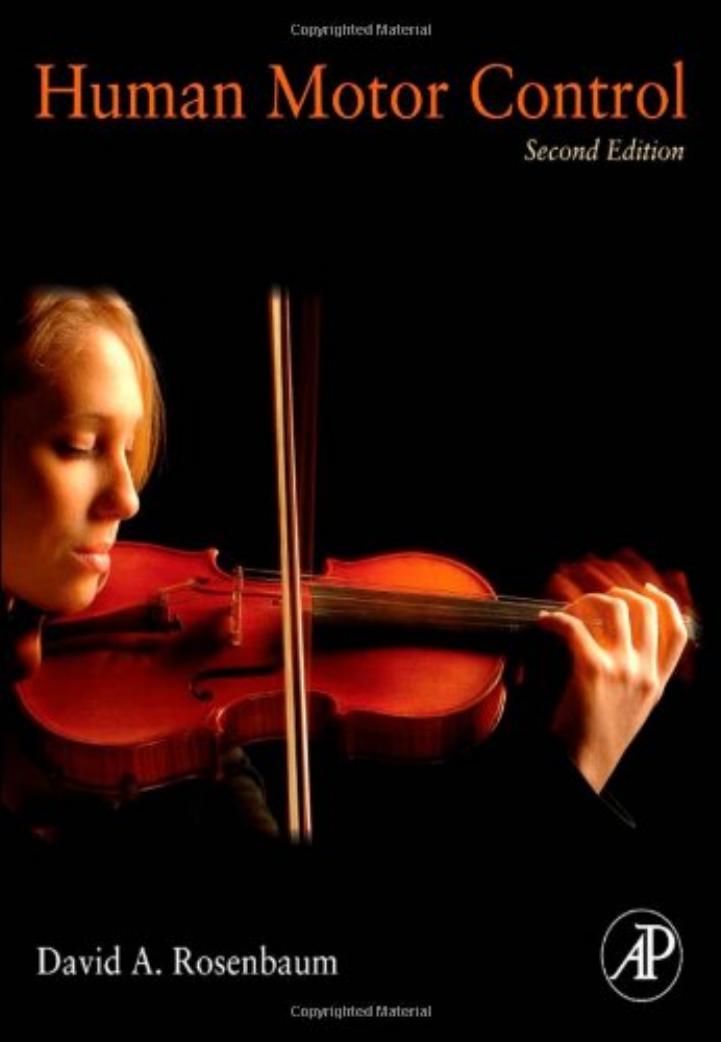Human Motor Control by David A. Rosenbaum

Author:David A. Rosenbaum [Rosenbaum, David A.]
Language: eng
Format: epub, pdf
ISBN: 978-0-12-374226-1
Publisher: Elsevier Science
Published: 2010-10-15T04:00:00+00:00
Summary
1. Writing and drawing may be controlled through a series of stages—from ideas to graphic segments to motor commands.
2. A demonstration of the validity of the stage model is the preservation of writing styles across different means of writing—for example, when writing with different parts of the body or when writing over differently sized spaces such as a blackboard or a bank check. Some questions for research on drawing and writing are why individuals write with different styles and why, for most people, writing and drawing are easier with the right hand than the left.
3. To draw, one must determine the order in which drawing strokes are made. Research on drawing in children and adults suggests that rules may be called upon during the planning of drawing behavior. The rules may ensure mechanical efficiency, but other factors—notably the semantic interpretation of the figure to be drawn—may also affect the order in which strokes are produced. Semantic biases in drawing provide additional support for the view that drawing, and graphic behavior in general, is largely a top-down process.
4. A way to study the execution of drawing strokes is to record the kinematics of the pen during simple, repetitive drawing tasks such as scribbling, drawing figure eights, or drawing spirals. Research on such elementary drawing tasks has suggested the isogony principle, which asserts that equal angles are covered in equal times. The isogony principle implies that figures are segmented into manageable pieces by the graphic production system and that an effort is made to produce segments, or sets of segments, in equal amounts of time.
5. Another control principle that has emerged from studies of drawing is the two-thirds power law. According to this principle, angular velocity increases with curvature and also with arc length.
6. A possible explanation of the two-thirds power law is based on the coupling of oscillators. Another possible explanation is based on the assumption that it is desirable to move as smoothly as possible. It may be that two-thirds power law is based on both factors.
7. Another way to study the control of handwriting is to classify the kinds of errors that writers make. Based on one such classification scheme, four stages may be identified for the generation of handwriting. The outputs of these stages are (a) words, (b) graphemes or letters, (c) allographs or letter forms, such as upper- and lowercase versions of the same letter, and (d) graphs or strokes.
8. People with the neurological disorder known as dysgraphia display errors consistent with the hierarchical stage model. Some dysgraphic patients have difficulty producing well-formed writing strokes, though their spelling and word choices are appropriate. Others produce well-formed writing strokes but have difficulty spelling (in writing only), though their word choices are legitimate.
9. Reaction time studies with normal individuals lend further support to the hierarchical model of writing. Facilitation of reaction times in various task conditions suggests that people can selectively ready grapheme-level (letter-level) programs.
10. Other reaction time results suggest that people can also selectively ready allograph-level programs (programs for the same letter appearing in different forms).
Download
This site does not store any files on its server. We only index and link to content provided by other sites. Please contact the content providers to delete copyright contents if any and email us, we'll remove relevant links or contents immediately.
| Administration & Medicine Economics | Allied Health Professions |
| Basic Sciences | Dentistry |
| History | Medical Informatics |
| Medicine | Nursing |
| Pharmacology | Psychology |
| Research | Veterinary Medicine |
The Art of Thinking Clearly by Rolf Dobelli(10326)
The 5 Love Languages: The Secret to Love That Lasts by Gary Chapman(9700)
Mindhunter: Inside the FBI's Elite Serial Crime Unit by John E. Douglas & Mark Olshaker(9265)
Becoming Supernatural by Dr. Joe Dispenza(8169)
Nudge - Improving Decisions about Health, Wealth, and Happiness by Thaler Sunstein(7659)
The Road Less Traveled by M. Scott Peck(7556)
Mastermind: How to Think Like Sherlock Holmes by Maria Konnikova(7279)
Enlightenment Now: The Case for Reason, Science, Humanism, and Progress by Steven Pinker(7274)
Win Bigly by Scott Adams(7140)
The Way of Zen by Alan W. Watts(6555)
Factfulness: Ten Reasons We're Wrong About the World – and Why Things Are Better Than You Think by Hans Rosling(4713)
The State of Affairs by Esther Perel(4688)
Gerald's Game by Stephen King(4610)
Man's Search for Meaning by Viktor Frankl(4503)
The Confidence Code by Katty Kay(4220)
Thinking in Bets by Annie Duke(4185)
The Healing Self by Deepak Chopra(3526)
Hidden Persuasion: 33 psychological influence techniques in advertising by Marc Andrews & Matthijs van Leeuwen & Rick van Baaren(3519)
The Worm at the Core by Sheldon Solomon(3450)
